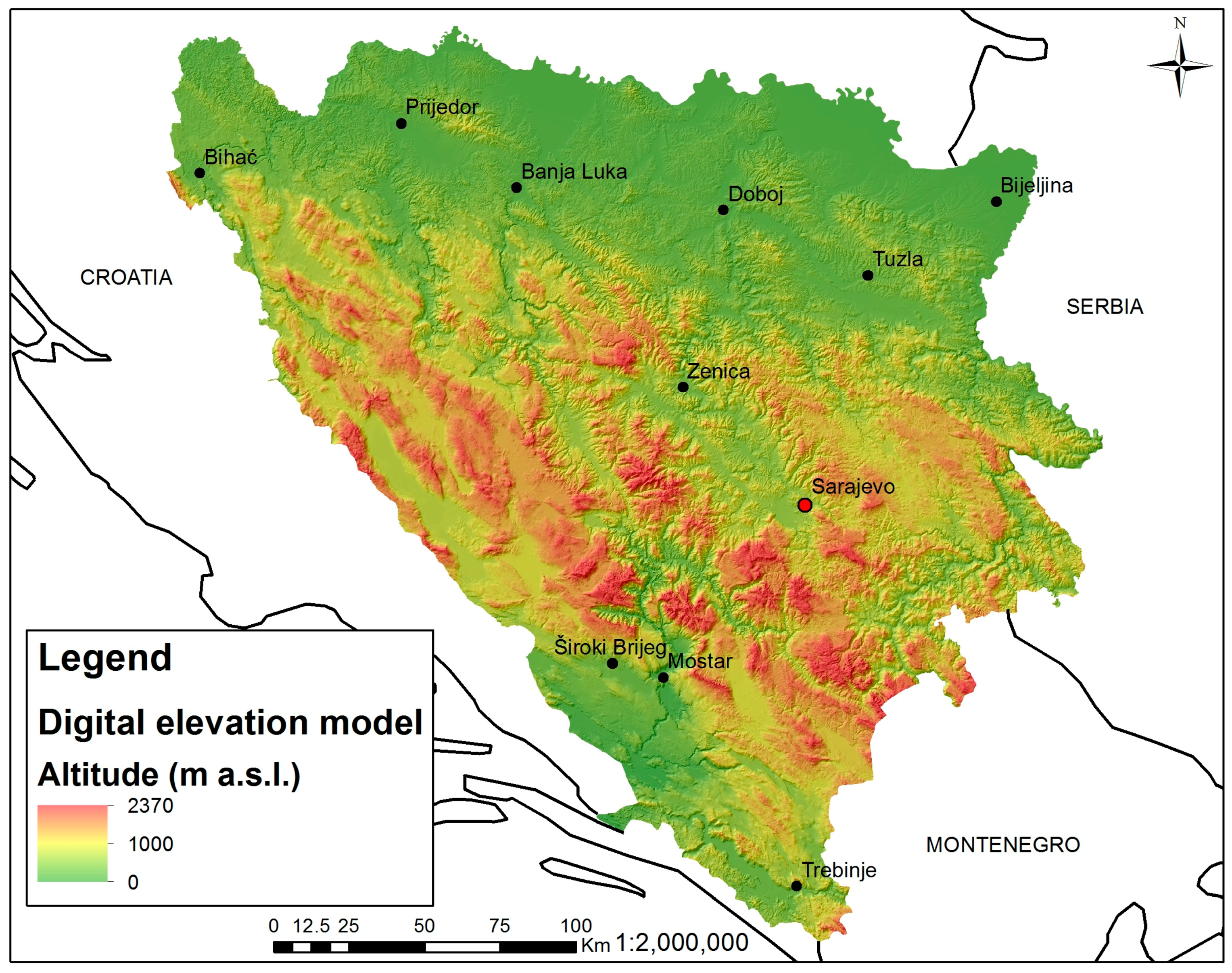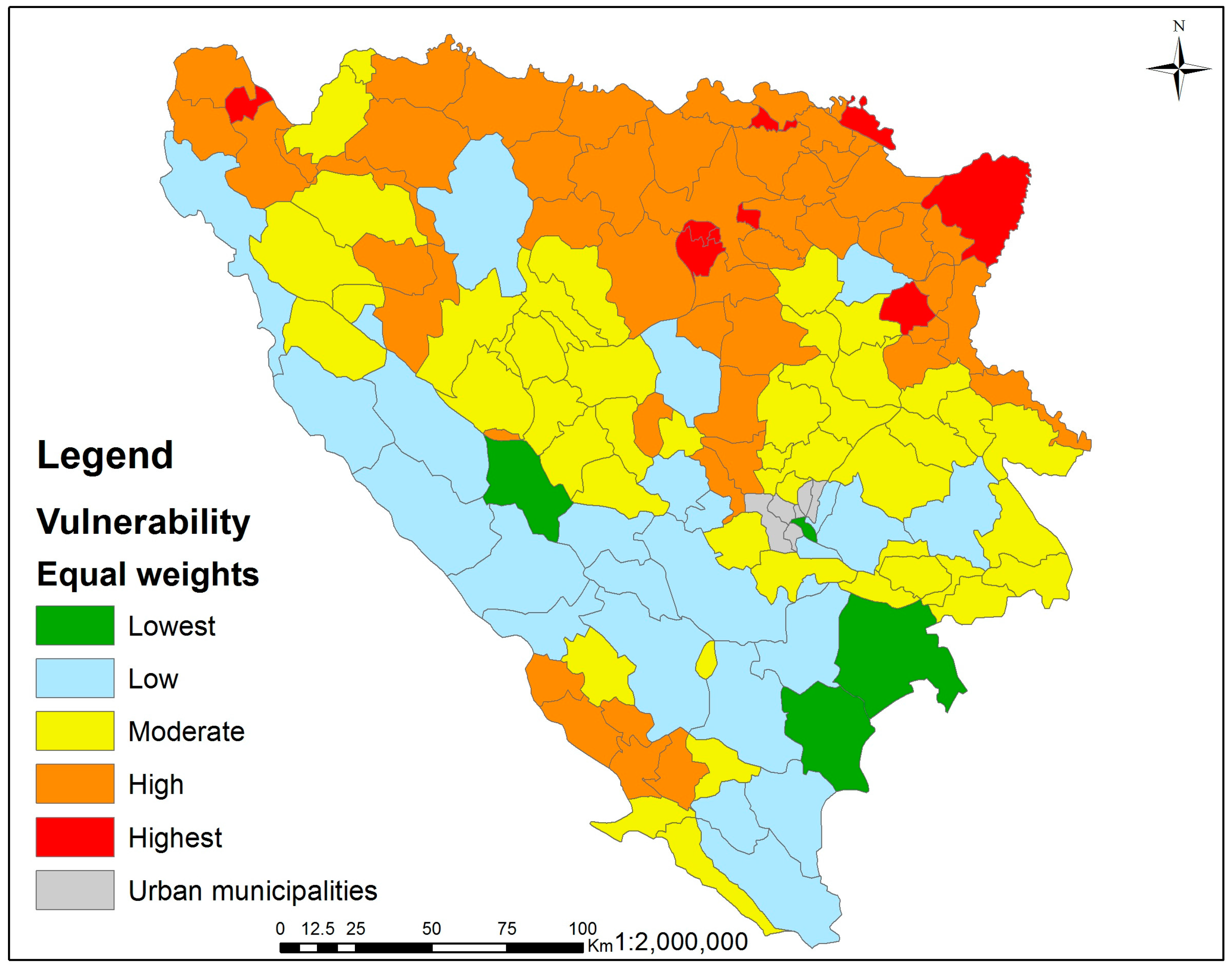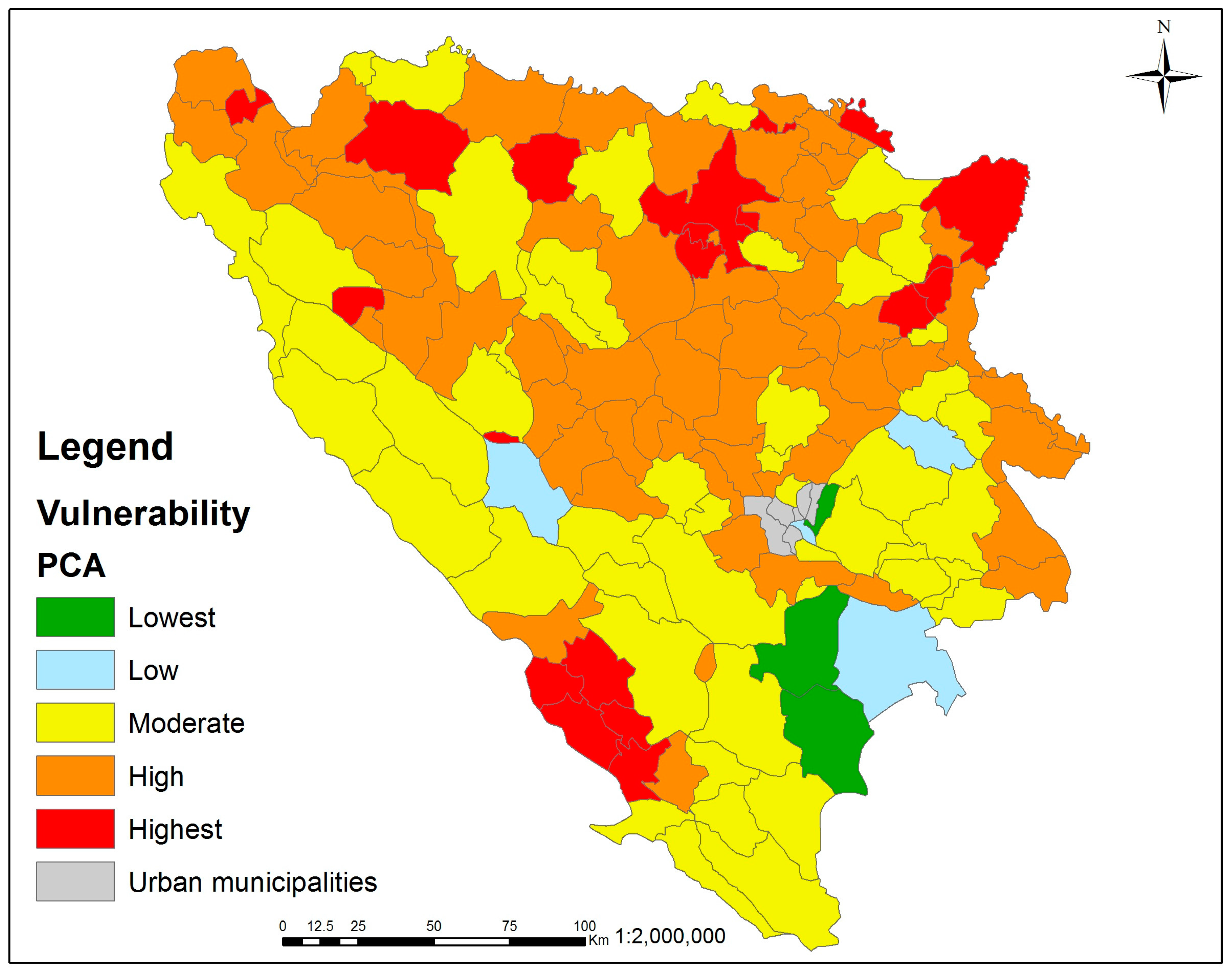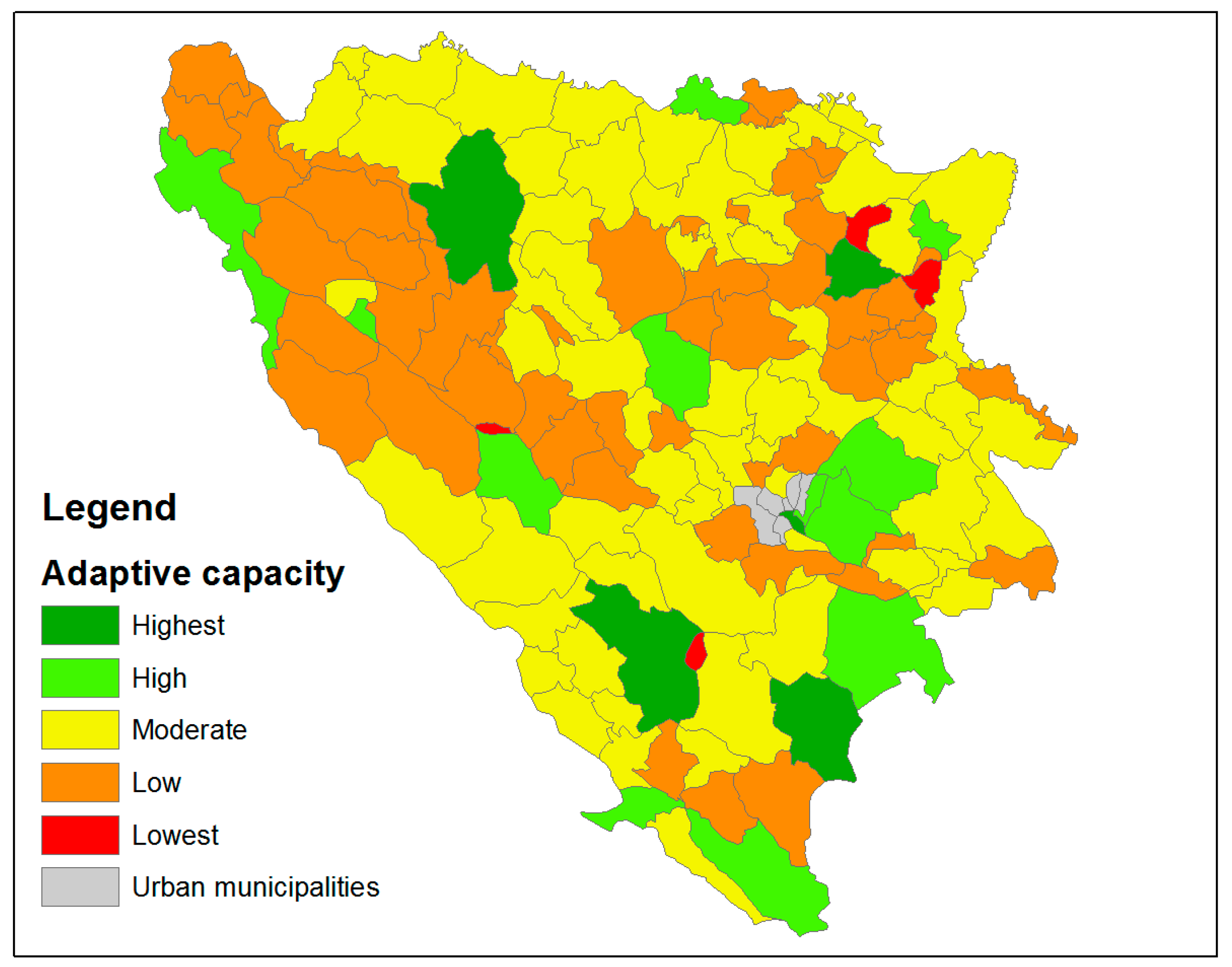Quantitative Assessment of Vulnerability to Climate Change in Rural Municipalities of Bosnia and Herzegovina
Abstract
:1. Introduction
2. Choice of Framework and Indicators
2.1. Choice of Framework
2.2. Choice of Indicators
3. Study Area
4. Methods
4.1. Normalization of Indicators and Their Functional Relationships with Vulnerability
4.2. Summarizing and Weighting Methods
4.3. Data Processing and Representation
5. Results and Discussion
5.1. The Overall Vulnerability Index
5.2. Influence of Different Components of Vulnerability on the Overall Vulnerability Index
5.3. Future Considerations for Quantitative Assessment of Vulnerability to Climate Change with Special Focus on Choice of Biophysical Indicators
6. Conclusions
Supplementary Materials
Acknowledgments
Author Contributions
Conflicts of Interest
References
- United Nations Framework Convention on Climate Change (UNFCCC). Initial National Communication of Bosnia and Herzegovina under the United Nation Framework Convention on Climate Change (INCBiH); Ministry for Spatial Planning, Construction and Ecology of Republic of Srpska: Banja Luka, Bosnia and Herzegovina, 2009.
- Zurovec, O.; Vedeld, P.O.; Sitaula, B.K. Agricultural sector of Bosnia and Herzegovina and climate change—Challenges and opportunities. Agriculture 2015, 5, 245–266. [Google Scholar] [CrossRef]
- Sharma, V.; Reddy, B.; Sahu, N. Sustainable rural livelihoods approach for climate change adaptation in western Odisha, Eastern India. Dev. Pract. 2014, 24, 591–604. [Google Scholar] [CrossRef]
- Thompson, H.E.; Berrang-Ford, L.; Ford, J.D. Climate change and food security in Sub-saharan Africa: A systematic literature review. Sustainability 2010, 2, 2719. [Google Scholar] [CrossRef]
- Adger, W.N.; Agrawala, S.; Mirza, M.M.Q.; Conde, C.; O’Brien, K.; Pulhin, J.; Pulwarty, R.; Smit, B.; Takahashi, K. Assessment of adaptation practices, options, constraints and capacity. In Climate Change 2007: Impacts, Adaptation and Vulnerability (Contribution of Working Group II to the Fourth Assessment Report of the Intergovernmental Panel On Climate Change); Parry, M., Canziani, O., Palutikof, J., van der Linden, P., Hanson, C., Eds.; Cambridge University Press: Cambridge, UK, 2007. [Google Scholar]
- Sullivan, C.; Meigh, J. Targeting attention on local vulnerabilities using an integrated index approach: The example of the climate vulnerability index. Water. Sci. Technol. 2005, 51, 69–78. [Google Scholar] [PubMed]
- Council of Ministers of Bosnia and Herzegovina. Climate Change Adaptation and Low-Emission Development Strategy for Bosnia and Herzegovina. Available online: http://www.ba.undp.org/content/bosnia_and_herzegovina/en/home/library/environment_energy/climate-change-adaptation-and-low-emission-development-strategy-/ (accessed on 4 August 2016).
- United Nations Framework Convention on Climate Change (UNFCCC). Second National Communication of Bosnia and Herzegovina under the United Nation Framework Convention on Climate Change (SNCBIH); Ministry for Spatial Planning, Construction and Ecology of Republic of Srpska: Banja Luka, Bosnia and Herzegovina, 2013.
- Agrawal, A. Local institutions and adaptation to climate change. In Social Dimensions of Climate Change: Equity and Vulnerability in a Warming World; Mearns, R., Ed.; The World Bank: Washington, DC, USA, 2010; pp. 173–198. [Google Scholar]
- Preston, B.L.; Brooke, C.; Measham, T.G.; Smith, T.F.; Gorddard, R. Igniting change in local government: Lessons learned from a bushfire vulnerability assessment. Mitig. Adapt. Strateg. Glob. Chang. 2009, 14, 251–283. [Google Scholar] [CrossRef]
- Füssel, H.-M. Vulnerability: A generally applicable conceptual framework for climate change research. Glob. Environ. Chang. 2007, 17, 155–167. [Google Scholar] [CrossRef]
- Gbetibouo, G.A.; Ringler, C.; Hassan, R. Vulnerability of the South African farming sector to climate change and variability: An indicator approach. Nat. Resour. Forum 2010, 34, 175–187. [Google Scholar] [CrossRef]
- Brooks, N. Vulnerability, Risk and Adaptation: A Conceptual Framework; Tyndall Centre for Climate Change Research and Centre for Social and Economic Research on the Global Environment (CSERGE), School of Environmental Sciences University of East Anglia: Norwich, UK, 2003; pp. 1–16. [Google Scholar]
- Kelly, P.M.; Adger, W.N. Theory and practice in assessing vulnerability to climate change and facilitating adaptation. Clim. Chang. 2000, 47, 325–352. [Google Scholar] [CrossRef]
- Adger, W.N. Social vulnerability to climate change and extremes in coastal vietnam. World Dev. 1999, 27, 249–269. [Google Scholar] [CrossRef]
- Intergovernmental Panel on Climate Change (IPCC). Climate Change 2001: Synthesis Report. A Contribution of Working Groups I, II, and III to the Third Assessment Report of the Integovernmental Panel on Climate Change; Watson, R.T., Core Writing Team, Eds.; Cambridge University Press: Cambridge, UK; New York, NY, USA, 2001; p. 398. [Google Scholar]
- Füssel, H.-M.; Klein, R.J.T. Climate change vulnerability assessments: An evolution of conceptual thinking. Clim. Chang. 2006, 75, 301–329. [Google Scholar] [CrossRef]
- Adger, W.N.; Brooks, N.; Bentham, G.; Agnew, M.; Eriksen, S. New Indicators of Vulnerability and Adaptive Capacity; Tyndall Centre for Climate Change Research: Norwich, UK, 2004. [Google Scholar]
- Berjan, S.; Jovanović, M.; Mrdalj, V.; Paspalj, M.; Matović, F.; Driouech, N.; El Bilali, H.; Abouabdillah, A. Rural livelihood diversification in south-eastern Bosnia: Influence of household financial management. Int. J. Environ. Rural Dev. 2014, 5, 17–22. [Google Scholar]
- Monterroso, A.; Conde, C.; Gay, C.; Gómez, D.; López, J. Two methods to assess vulnerability to climate change in the Mexican agricultural sector. Mitig. Adapt. Strateg. Glob. Chang. 2014, 19, 445–461. [Google Scholar] [CrossRef]
- O’Brien, K.; Leichenko, R.; Kelkar, U.; Venema, H.; Aandahl, G.; Tompkins, H.; Javed, A.; Bhadwal, S.; Barg, S.; Nygaard, L.; et al. Mapping vulnerability to multiple stressors: Climate change and globalization in India. Glob. Environ. Chang. 2004, 14, 303–313. [Google Scholar] [CrossRef]
- Ravindranath, N.; Rao, S.; Sharma, N.; Nair, M.; Gopalakrishnan, R.; Rao, A.S.; Malaviya, S.; Tiwari, R.; Sagadevan, A.; Munsi, M. Climate change vulnerability profiles for north east India. Curr. Sci. India 2011, 101. [Google Scholar]
- Wiréhn, L.; Danielsson, Å.; Neset, T.-S.S. Assessment of composite index methods for agricultural vulnerability to climate change. J. Environ. Manag. 2015, 156, 70–80. [Google Scholar] [CrossRef] [PubMed]
- Palmer, W.C. Meteorological Drought; US Department of Commerce, Weather Bureau Washington: Washington, DC, USA, 1965; Volume 30.
- Hydro-Engineering Institute Sarajevo (HEIS). Assessment on Floods and Landslides Risk for the Housing Sector in Bosnia and Herzegovina; Hydro-Engineering Institute: Sarajevo, Bosnia and Herzegovina, 2015. [Google Scholar]
- Federal Institute for Agropedology. FAO Soil and Terrain Database (SOTER) for Bosnia and Herzegovina: Dominant Soil Types, Scale 1:1000000; Federal Institute for Agropedology: Sarajevo, Bosnia and Herzegovina, 2000. [Google Scholar]
- European Environment Agency (EEA). Corine Land Cover Database—Bosnia and Herzegovina. Available online: http://cdr.eionet.europa.eu/ba/eea/clc/envvu5ofg (accessed on 16 August 2015).
- Agency for Statistics of Bosnia and Herzegovina—Census 2013 Data. Available online: http://popis2013.ba/ (accessed on 3 July 2016).
- Institute for Statistics of Federation of Bosnia and Herzegovina—Kantoni U Brojkama (Cantons in Numbers). Available online: http://www.fzs.ba/kantoniubrojkama.htm (accessed on 22 April 2016).
- Institute for Statistics of Republic of Srpska—Statistical Yearbook of Republic of Srpska 2014: Review by Municipalities. Available online: http://www.rzs.rs.ba/front/article/1331/?left_mi=287&add=287 (accessed on 22 April 2015).
- Ministry of Justice of Bosnia and Herzegovina—Registry of Associations. Available online: http://www.mpr.gov.ba/web_dokumenti/RU_23_03_12.pdf (accessed on 13 July 2015).
- NGO Members of the Portal. Available online: http://www.ngo.ba/index.php/nvo-clanice-portala (accessed on 16 July 2015).
- Wells, N.; Goddard, S. A self-calibrating Palmer drought severity index. J. Clim. 2004, 17, 2335–2351. [Google Scholar] [CrossRef]
- Bruinsma, J. World Agriculture: Towards 2015/2030: An FAO Perspective; Earthscan: London, UK, 2003. [Google Scholar]
- Houghton, A.; Austin, J.; Beerman, A.; Horton, C. An approach to developing local climate change environmental public health indicators in a rural district. J. Environ. Public Health 2017, 2017, 1–16. [Google Scholar] [CrossRef] [PubMed]
- Muttarak, R.; Lutz, W. Is education a key to reducing vulnerability to natural disasters and hence unavoidable climate change? Ecol. Soc. 2014, 19, 42. [Google Scholar] [CrossRef]
- United Nations Development Programme (UNDP). Rural Development in Bosnia and Herzegovina: Myth and Reality. Available online: http://hdr.undp.org/en/content/rural-development-bosnia-and-herzegovina-myth-and-reality (accessed on 10 April 2017).
- Bajić, D.; Trbić, G. Climate Atlas of Bosnia and Herzegovina; Faculty of Science: Banja Luka, Bosnia and Herzegovina, 2016. [Google Scholar]
- European Environment Agency (EEA). Climate Change, Impacts and Vulnerability in Europe 2016; An Indicator-Based Report; EEA Report No 1/2017; European Environment Agency: Luxembourg, 2017. [Google Scholar]
- Brezzi, M.; Dijkstra, L.; Ruiz, V. OECD Extended Regional Typology: The Economic Performance of Remote Rural Regions; OECD Publishing: Paris, France, 2011. [Google Scholar]
- United Nations Development Programme (UNDP). Human Development Report: Concept and Measurement of Human Development; United Nations Development Programme: New York, NY, USA, 1990. [Google Scholar]
- Palanisami, K.; Paramasivam, P.; Ranganathan, C.; Aggarwal, P.; Senthilnathan, S. Quantifying vulnerability and impact of climate change on production of major crops in Tamil Nadu, India. In From Headwaters to the Ocean: Hydrological Change and Water Management-Hydrochange; Taniguchi, M., Burnett, W.C., Fukushima, Y., Haigh, M., Umezawa, Y., Eds.; CRC Press/Balkema: Boca Raton, FL, USA, 2008. [Google Scholar]
- Varadan, R.J.; Kumar, P. Mapping agricultural vulnerability of Tamil Nadu, India to climate change: A dynamic approach to take forward the vulnerability assessment methodology. Clim. Chang. 2015, 129, 159–181. [Google Scholar] [CrossRef]
- Yusuf, A.A.; Francisco, H. Climate Change Vulnerability Mapping for Southeast Asia; Economy and Environment Program for Southeast Asia (EEPSEA): Singapore, 2009; pp. 10–15. [Google Scholar]
- Kaiser, H.F. The application of electronic computers to factor analysis. Educ. Psychol. Meas. 1960, 20, 141–151. [Google Scholar] [CrossRef]
- Cutter, S.L.; Boruff, B.J.; Shirley, W.L. Social vulnerability to environmental hazards. Soc. Sci. Q. 2003, 84, 242–261. [Google Scholar] [CrossRef]
- Saisana, M.; Tarantola, S. State-of-the-Art Report on Current Methodologies and Practices for Composite Indicator Development; European Commission, Joint Research Centre: Ispra, Italy, 2002. [Google Scholar]
- Alagić, I.; Petković, D. Economic Development of Small Areas Based on Own Resources as Opposed to Existence/Nonexistence of the Support of the Capital City. In Special editions of The Academy of Sciences and Arts of Bosnia and Herzegovina, Department of Social Science, Book 6; Osmanković, J., Pejanović, M., Eds.; The Academy of Sciences and Arts of Bosnia and Herzegovina: Sarajevo, Bosnia and Herzegovina, 2016; pp. 179–194. [Google Scholar]
- Tate, E. Uncertainty analysis for a social vulnerability index. Ann. Assoc. Am. Geogr. 2013, 103, 526–543. [Google Scholar] [CrossRef]
- Vincent, K.; Cull, T. Using indicators to assess climate change vulnerabilities: Are there lessons to learn for emerging loss and damage debates? Geogr. Compass 2014, 8, 1–12. [Google Scholar] [CrossRef]
- Wilhite, D.A. Drought as a natural hazard: Concepts and definitions. In Drought: A Global Assessment; Wilhite, D.A., Ed.; Routledge: London, UK, 2000; Volume 2, pp. 3–18. [Google Scholar]
- Zarafshani, K.; Sharafi, L.; Azadi, H.; Van Passel, S. Vulnerability assessment models to drought: Toward a conceptual framework. Sustainability 2016, 8, 588. [Google Scholar] [CrossRef]
- Wilhite, D.A.; Glantz, M.H. Understanding: The drought phenomenon: The role of definitions. Water Int. 1985, 10, 111–120. [Google Scholar] [CrossRef]
- Moore, G.A. Soilguide. In A Handbook for Understanding and Managing Agricultural Soils; Department of Agriculture and Food, Bulletin No. 4343; Department of Agriculture and Food: Perth, Australia, 2001; Chapter 3. [Google Scholar]
- Dickin, E.; Wright, D. The effects of winter waterlogging and summer drought on the growth and yield of winter wheat (Triticum Aestivum L.). Eur. J. Agron. 2008, 28, 234–244. [Google Scholar] [CrossRef]
- Drew, M.C.; Lynch, J.M. Soil anaerobiosis, microorganisms, and root function. Annu. Rev. Phytopathol. 1980, 18, 37–66. [Google Scholar] [CrossRef]
- Turtola, E.; Paajanen, A. Influence of improved subsurface drainage on phosphorus losses and nitrogen leaching from a heavy clay soil. Agric. Water Manag. 1995, 28, 295–310. [Google Scholar] [CrossRef]
- McKee, T.B.; Doesken, N.J.; Kleist, J. The relationship of drought frequency and duration to time scales. In Proceedings of the 8th Conference on Applied Climatology, American Meteorological Society, Anaheim, CA, USA, 17–22 January 1993; Volume 17, pp. 179–183. [Google Scholar]
- Vicente-Serrano, S.M.; Beguería, S.; Lorenzo-Lacruz, J.; Camarero, J.J.; López-Moreno, J.I.; Azorin-Molina, C.; Revuelto, J.; Morán-Tejeda, E.; Sanchez-Lorenzo, A. Performance of drought indices for ecological, agricultural, and hydrological applications. Earth Interact. 2012, 16, 1–27. [Google Scholar] [CrossRef]
- World Meteorological Organization (WMO). Standardized Precipitation Index User Guide; World Meteorological Organization: Geneva, Switzerland, 2012. [Google Scholar]
- Vicente-Serrano, S.M.; Beguería, S.; López-Moreno, J.I. A multiscalar drought index sensitive to global warming: The standardized precipitation evapotranspiration index. J. Clim. 2010, 23, 1696–1718. [Google Scholar] [CrossRef]
- Potop, V.; Možný, M.; Soukup, J. Drought evolution at various time scales in the lowland regions and their impact on vegetable crops in the Czech Republic. Agric. For. Meteorol. 2012, 156, 121–133. [Google Scholar] [CrossRef]
- Yu, M.; Li, Q.; Hayes, M.J.; Svoboda, M.D.; Heim, R.R. Are droughts becoming more frequent or severe in China based on the standardized precipitation evapotranspiration index: 1951–2010? Int. J. Climatol. 2014, 34, 545–558. [Google Scholar] [CrossRef]





| Component | Indicator | Functional Relationship * | Source |
|---|---|---|---|
| Exposure | Changes in average annual temperatures between reference periods 1960–1990 and 1981–2010 1 | + | [8] |
| Changes in average annual precipitation between reference periods 1960–1990 and 1981–2010 1 | + | [8] | |
| Frequency of extreme months in the vegetation period (both dry and wet) in the analyzed period (1961–2010) according to the Palmer moisture anomaly index (Z Index) [24] | + | Authors * | |
| Flood risk assessment for the housing sector 1,a | + | [25] | |
| Sensitivity | Soil depth 2 | - | [26] |
| Percentage of agricultural land 4 | + | [27] | |
| Percentage of households engaged in agricultural production 2,a | + | [28] | |
| Percentage of rural population b | + | [29,30] | |
| Arable land per capita c | - | [27,28] | |
| Population density 1,3 | + | [28] | |
| Adaptive capacity | Unemployment rate 1 | + | [29,30] |
| GDP per capita 5 | - | [29,30] | |
| Dependency ratio 4 | - | [28] | |
| Literacy rate 1 | - | [28] | |
| Percentage of population with higher education d | - | [28] | |
| Schools per 1000 population 1 | - | [29,30] | |
| Doctors per 1000 population 1 | - | [29,30] | |
| Road length per sq. km 2 | [29,30] | ||
| Social capital (derived from total number of associations, NGOs, and foundations) 1,a | - | [31,32] | |
| Average yield for major crops (based on the yields of wheat, maize, potato, and main fruits) 3,4 | - | [29,30] |
| Municipality | Potential impact | Adaptive Capacity | ||
|---|---|---|---|---|
| Exposure | Sensitivity | Overall | ||
| Bijeljina | highest | moderate | highest | moderate |
| Doboj-Jug | moderate | highest | highest | moderate |
| Doboj-Istok | moderate | high | high | low |
| Orašje | moderate | high | highest | moderate |
| Usora | moderate | high | high | low |
| Tešanj | moderate | high | high | moderate |
| Kalesija | low | high | high | low |
| Bužim | moderate | high | high | low |
| Vukosavlje | moderate | moderate | high | low |
© 2017 by the authors. Licensee MDPI, Basel, Switzerland. This article is an open access article distributed under the terms and conditions of the Creative Commons Attribution (CC BY) license (http://creativecommons.org/licenses/by/4.0/).
Share and Cite
Žurovec, O.; Čadro, S.; Sitaula, B.K. Quantitative Assessment of Vulnerability to Climate Change in Rural Municipalities of Bosnia and Herzegovina. Sustainability 2017, 9, 1208. https://doi.org/10.3390/su9071208
Žurovec O, Čadro S, Sitaula BK. Quantitative Assessment of Vulnerability to Climate Change in Rural Municipalities of Bosnia and Herzegovina. Sustainability. 2017; 9(7):1208. https://doi.org/10.3390/su9071208
Chicago/Turabian StyleŽurovec, Ognjen, Sabrija Čadro, and Bishal Kumar Sitaula. 2017. "Quantitative Assessment of Vulnerability to Climate Change in Rural Municipalities of Bosnia and Herzegovina" Sustainability 9, no. 7: 1208. https://doi.org/10.3390/su9071208




